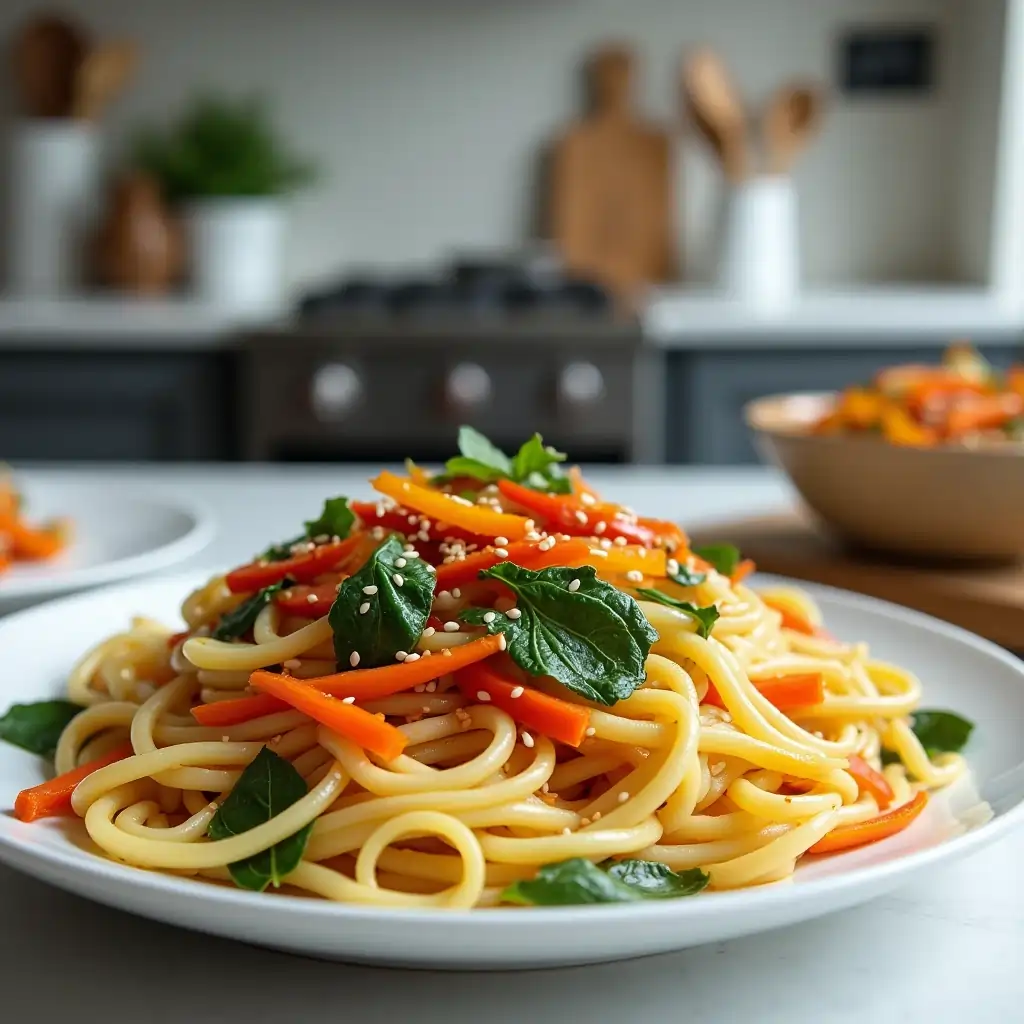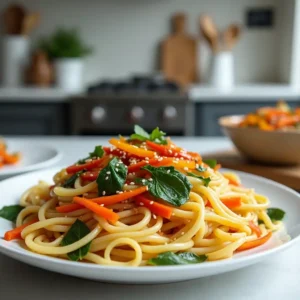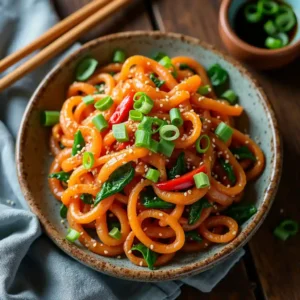Key Takeaways
Potato noodles are a versatile, gluten-free option that can be adapted to suit any taste or cuisine. They’re easy to make with just a few simple ingredients and can be customized with different sauces, proteins, and vegetables. Whether you’re preparing a creamy Italian dish or an authentic Korean Japchae, potato noodles are sure to impress. With the tips and techniques in this guide, you’ll be able to create a dish that’s both satisfying and delicious.
What Are Potato Noodles?
Potato noodles are soft, chewy noodles made from either potato starch or mashed potatoes. They have a unique texture that absorbs sauces beautifully, making them a versatile option for various cuisines. You might recognize them from Korean dishes like Japchae, where sweet potato noodles are combined with stir-fried vegetables and soy sauce. These noodles are naturally gluten-free and easy to adapt to your taste preferences.
The origins of potato noodles can be traced back to Asian and European cuisines. In Asia, sweet potato noodles are a staple, particularly in Korean cooking. In Europe, you’ll find variations like potato-based dumplings, known as kluski in Poland. Their global popularity comes from their simplicity and ability to complement any sauce or seasoning.
Ingredients for Potato Noodles Recipe
To make potato noodles, you’ll need just a few basic ingredients that are easy to find. Here’s a breakdown of what you’ll need:
| Ingredient | Quantity |
|---|---|
| Potatoes (boiled and mashed) | 2 cups |
| Potato starch | 1 cup |
| All-purpose flour (optional) | ½ cup |
| Salt | ½ tsp |
| Water | As needed |
| Your choice of sauce | 1 cup |
| Optional toppings | Cheese, herbs, sesame seeds |
If you’re making a sweet potato noodles recipe, substitute sweet potato starch for potato starch. This creates a translucent noodle perfect for Korean-style dishes.
Step-by-Step Potato Noodles Recipe
Making potato noodles at home is straightforward and rewarding. Follow these steps for perfect noodles every time:
Preparing the Dough
Start by boiling your potatoes until they are soft enough to mash. Peel them and mash thoroughly to remove any lumps. In a mixing bowl, combine the mashed potatoes with potato starch and salt. If you want firmer noodles, add a little all-purpose flour to the mixture. Knead the dough until it’s smooth and pliable, adding water if needed to bring it together.
Shaping the Noodles
Divide the dough into small portions. Roll each portion into thin ropes, about the thickness of a pencil, and cut them into small pieces. For a more uniform shape, you can use a pasta maker or noodle press.
Cooking the Noodles
Heat a large pot of water, adding a generous pinch of salt, and bring it to a rolling boil. Slowly add the noodles in small portions, ensuring they have enough room to cook evenly without sticking together.. Allow the noodles to gently simmer until they float to the surface, usually taking about 2-3 minutes, which indicates they are fully cooked. Carefully scoop them out with a slotted spoon and immediately place them in a bowl of cold water to halt the cooking process and maintain their texture.
Adding the Sauce
Once the noodles are cooked, toss them with your choice of sauce. Popular options include garlic butter, marinara, or a simple soy-based sauce. Garnish with fresh herbs, grated cheese, or sesame seeds for an extra touch of flavor.
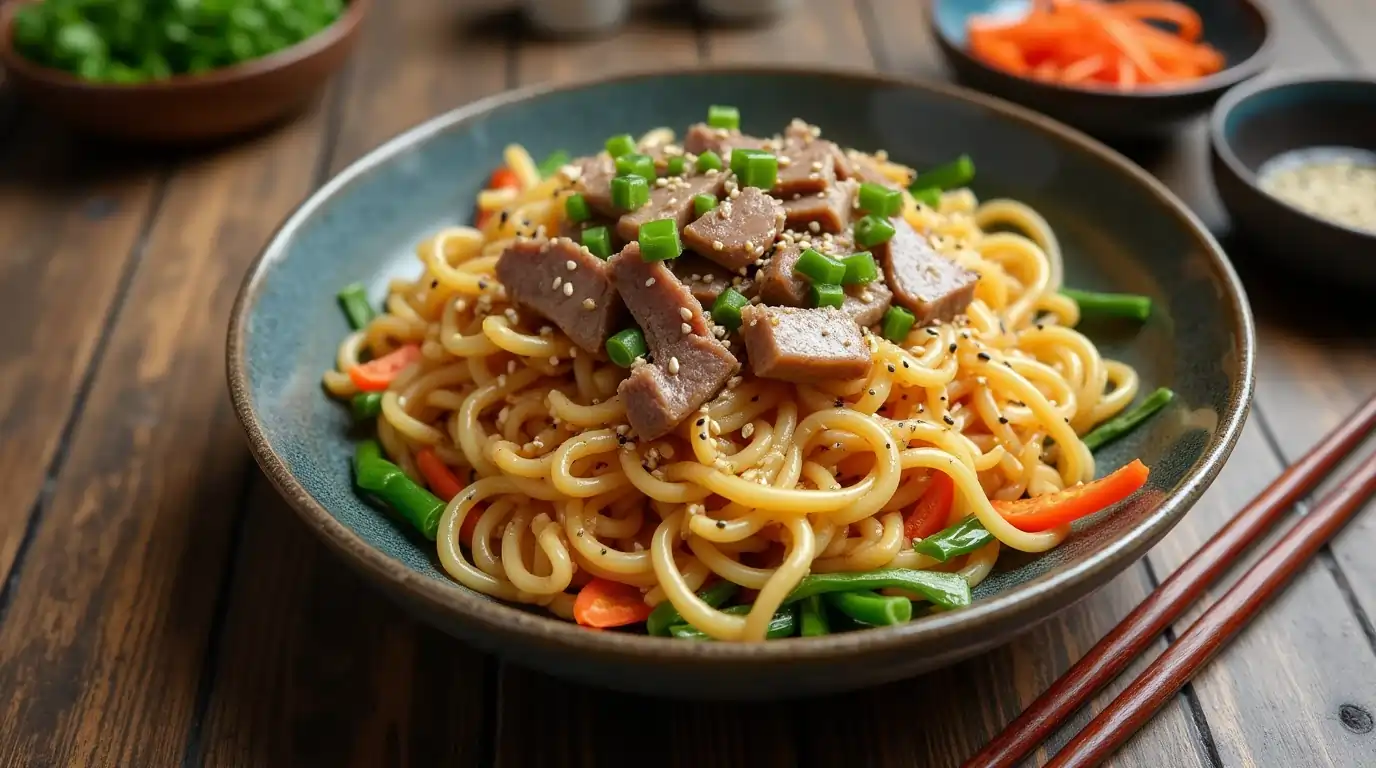
Tips for Making Perfect Potato Noodles
To ensure your potato noodles turn out just right, keep these tips in mind:
- Opt for starchy potatoes, such as Russets, to achieve the ideal texture for your noodles.
- Don’t over-knead the dough, which can make the noodles too tough.
- If the dough feels sticky, add a little more potato starch until it’s easy to handle.
- Always test one noodle in boiling water before cooking the entire batch to ensure the consistency is correct.
Popular Variations of Potato Noodles Recipe
Potato noodles can be adapted to suit a variety of cuisines and dietary preferences. Here are some popular variations to try:
Korean Potato Noodles Recipe (Dangmyeon)
For an authentic Korean experience, use sweet potato starch to make translucent noodles. Stir-fry them with carrots, spinach, onions, and beef or tofu, and season with soy sauce, sesame oil, and garlic for a traditional Japchae dish.
Creamy Italian Potato Noodles
Toss your noodles with a rich Alfredo or carbonara sauce for a decadent Italian twist. Add sautéed mushrooms or grilled chicken for extra protein.
Vegan and Gluten-Free Potato Noodles
Skip the flour and use only potato starch for a gluten-free option. Pair with a vegan tomato sauce or cashew cream sauce for a plant-based meal.
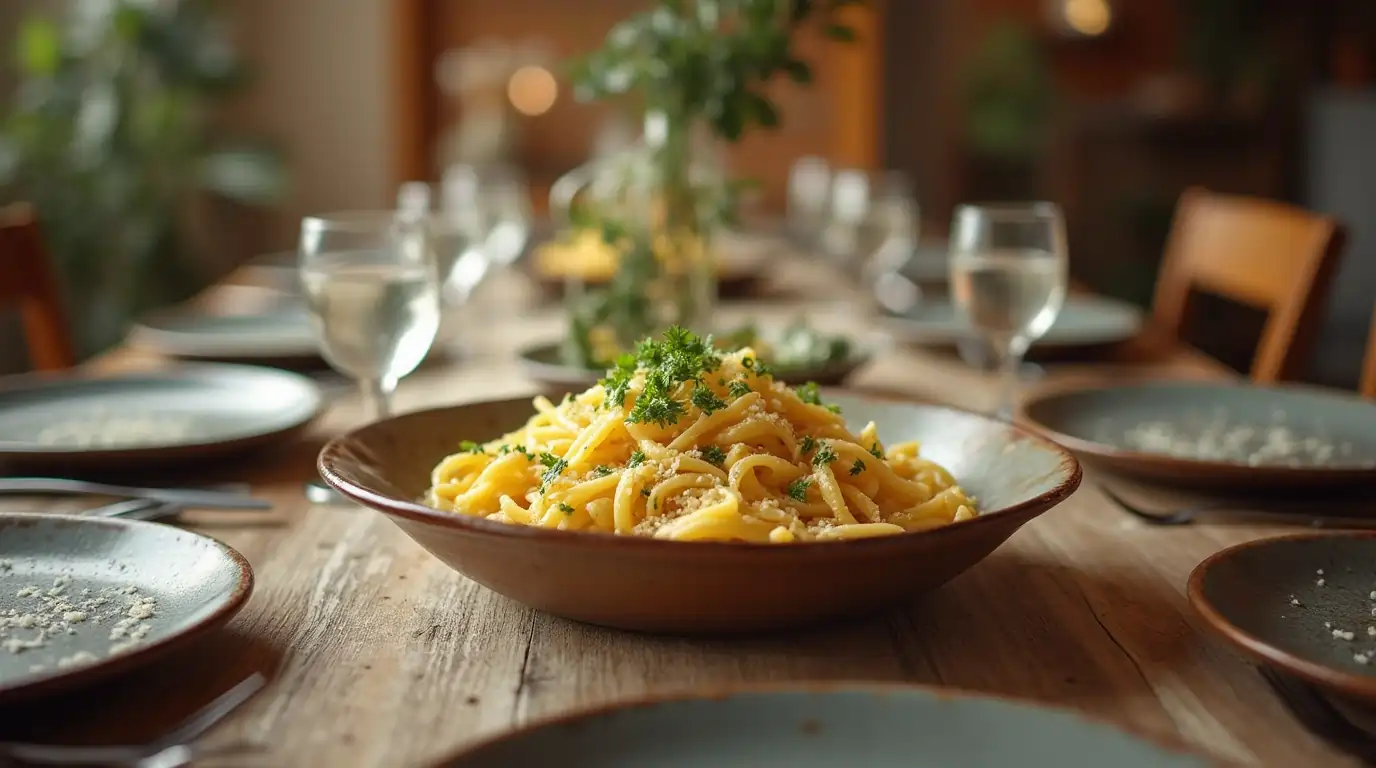
Nutritional Benefits of Potato Noodles
Potato noodles are not just delicious—they’re also nutritious. They’re naturally gluten-free, making them a great option for those with gluten sensitivities or celiac disease. When paired with vegetables and lean proteins, they provide a balanced meal that’s low in fat and high in essential nutrients like potassium and vitamin C from the potatoes.
Creative Serving Ideas for Potato Noodles
Potato noodles are incredibly versatile, making them a fantastic base for a variety of dishes. Here are some creative ways to serve them:
- Noodle Bowls: Layer potato noodles with fresh or sautéed vegetables, and proteins like chicken or tofu, and drizzle with a savory sauce like peanut or sesame dressing for a hearty meal.
- Stir-Fries: Toss the noodles in a wok with soy sauce, garlic, ginger, and your favorite veggies for a quick and flavorful dish.
- Casseroles: Use potato noodles as a substitute for lasagna sheets or in baked casseroles with creamy sauce and cheese.
- Soups: Add cooked potato noodles to broths, whether it’s chicken, vegetable, or miso-based, for a warm and comforting dish.
- Cold Salads: Mix cooled potato noodles with chopped cucumbers, carrots, and a tangy vinaigrette for a refreshing side.
- Fusion Creations: Experiment by combining potato noodles with flavors from different cuisines, such as adding pesto for an Italian twist or curry for an Indian-inspired dish.
Potato Noodles vs. Traditional Pasta
Potato noodles and traditional pasta may look similar, but they differ significantly in texture, taste, and nutritional profile:
- Texture and Taste: Potato noodles are soft and chewy with a slightly springy texture, whereas traditional pasta is firmer and holds sauces differently.
- Ingredients: Traditional pasta is made from wheat flour and eggs, while potato noodles are gluten-free, using potato starch or mashed potatoes as the base.
- Health Benefits: Potato noodles are naturally gluten-free, making them suitable for those with celiac disease or gluten sensitivities. Traditional pasta often contains more protein but is higher in gluten.
- Cooking Time: Potato noodles typically cook faster than pasta, making them ideal for quick meals. However, they require careful handling to prevent overcooking.
- Flavor Absorption: Potato noodles excel at soaking up the flavors of sauces, while traditional pasta adds its own subtle flavor to the dish.
Storage and Reheating Tips
Proper storage and reheating ensure your potato noodles remain as delicious as when freshly made:
- Storing Uncooked Noodles: Lay the uncooked noodles on a baking sheet, dust lightly with potato starch to prevent sticking, and store them in an airtight container in the refrigerator for up to two days. For longer storage, freeze them individually before transferring them to a freezer-safe bag.
- Storing Cooked Noodles: Toss cooked noodles in a little oil to prevent them from clumping, then store them in an airtight container in the fridge for up to three days.
- Reheating Tips:
- Microwave: Heat the noodles on medium power in short intervals, stirring gently between each round.
- Stovetop: Warm the noodles in a pan with a splash of water or sauce to restore their softness and flavor.
- Avoid Overcooking: Reheat just until warm to preserve the noodles’ texture.
Kid-Friendly Potato Noodle Ideas
Potato noodles are a hit with kids thanks to their soft texture and fun shapes. Here’s how to make them even more appealing:
- Fun Shapes: Use cookie cutters or noodle presses to create star, heart, or animal-shaped noodles that make mealtime exciting.
- Cheesy Creations: Mix potato noodles with a creamy cheese sauce for a kid-approved meal that feels like an upgrade to mac and cheese.
- Colorful Noodles: Add natural color with spinach puree (green) or beet juice (pink) to make the dish visually engaging.
- Mini Bowls: Serve potato noodles in small bowls with simple toppings like grated cheese, peas, or diced chicken for manageable portions.
- Sweet Treats: Make dessert noodles by tossing them in a light syrup with cinnamon and raisins for a sweet twist.
Potato Noodles for Special Diets
The Potato noodles are naturally adaptable to suit a variety of dietary preferences:
- Gluten-Free: As they are made with potato starch or mashed potatoes, potato noodles are inherently gluten-free and an excellent alternative for those avoiding wheat.
- Vegan: Potato noodles contain no animal products, making them suitable for plant-based diets. Pair with vegan sauces like tomato basil, avocado cream, or coconut curry.
- Low-Sodium: Control the salt in your dish by using a low-sodium broth or soy sauce and enhancing flavor with fresh herbs and spices.
- Keto-Friendly: Replace potato starch with almond flour or coconut flour to make keto-friendly potato noodles, and pair them with high-fat, low-carb sauces.
- Low-Calorie: Skip heavy sauces and toss the noodles with steamed vegetables and a light dressing for a satisfying, lower-calorie meal.
Potato noodles are a dish that can be customized for anyone, no matter their dietary needs or taste preferences. With these ideas, you can enjoy them in endless ways!
FAQ About Potato Noodles Recipe
Can I freeze potato noodles?
Yes, you can freeze uncooked potato noodles. Lay them out on a baking sheet lined with parchment paper, freeze until firm, and then transfer them to a freezer-safe bag. Cook them directly from frozen to avoid sticking.
How do I prevent potato noodles from falling apart?
The key is to use the right ratio of potatoes to starch. If the dough feels too soft, add more starch to strengthen it. Avoid overcooking the noodles, as they can become mushy.
Are potato noodles healthy?
Absolutely! Potato noodles are low in fat and calories and offer a good source of energy from complex carbohydrates. They’re also naturally gluten-free, making them a healthier alternative to traditional pasta.
How do I make potato noodles recipe Korean-style?
To make a Korean potato noodles recipe, use sweet potato starch to create translucent noodles. Pair them with stir-fried vegetables and a savory soy-based sauce, garnished with sesame seeds and green onions.
Conclusion
Now that you’ve learned how to make potato noodles, it’s time to roll up your sleeves and get cooking. With their unique texture and ability to pair with any flavor, these noodles are a must-try for food lovers everywhere. Try out the variations, experiment with your favorite sauces, and don’t forget to share your creations with family and friends. What kind of potato noodles recipe will you make first? Let us know in the comments below!
